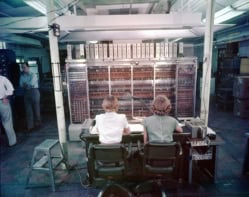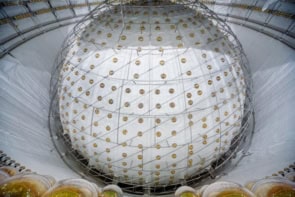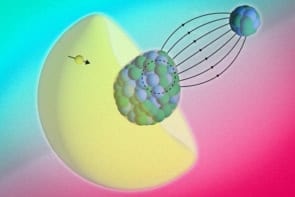John Ellis has spent almost four decades working at the CERN particle-physics lab. As he now returns to the UK, the 65-year-old theorist tells Michael Banks about the latest in the search for the Higgs

John Ellis is a busy man. When he is not clocking up air miles almost every week travelling between London and the CERN particle-physics lab near Geneva, then a string of appointments and meetings leave him just as hard to get hold of. Indeed, after waiting 40 minutes at his office before finally getting the chance to start our interview (Ellis had just flown in from Switzerland and had immediately gone into another meeting), our time together abruptly ran out as yet a further appointment loomed. A follow-up phone call was arranged with the caveat that “if I do not reply the first time, please try again – I am a bit in-and-out”.
The meetings and travel reflect a hectic time for Ellis. After turning 65 last month, the UK-born theorist had to relinquish a full-time position at CERN (although he still keeps his office at the lab and has a “guest professor” position). But instead of putting his feet up and “watching Doctor Who all day”, Ellis accepted a post at King’s College London that allows him to carry on doing his own research, as well as building up a group and mentoring students.
Ellis’s self-proclaimed “period of transition” comes at a time of high excitement at CERN as it ramps up the Large Hadron Collider (LHC) in its search for physics beyond the Standard Model. Ellis has worked at CERN for nearly 38 years, and has been part of the LHC from its very first days in 1984, when he was involved with imagining what potential science the LHC could do. With the LHC now about to possibly show the first signs of those predictions, he is very much looking forward to the coming year. “At the moment, it’s going gangbusters,” says Ellis. “This year the LHC is going to explore virgin territory. Whether there are any virgins in the territory, however, is an altogether different question.”
Of course, it was not always going gangbusters at CERN. In September 2008, just nine days after protons were circulated in both directions at the LHC, an electrical connection between a dipole magnet and a neighbouring quadrupole magnet failed, causing two tonnes of helium to be released with such force that some magnets broke their anchors to the concrete floor.
After CERN spent more than a year fixing the damage, the LHC is finally back on track, although it will close by the end of 2012 for another 18 months of repairs and upgrades. Ellis is frank about the failings, however. “Clearly, the blowout was a failure at a technical and management level,” he says. “I do wonder if we could have avoided it if we had been slower and more systematic in commissioning and testing the LHC – maybe there was too much of a hurry to get it into operation.”
Ellis admits there was a particular pressure to get the LHC ready before the end of the five-year term of then CERN director-general Robert Aymar in 2008. “I am not suggesting he was responsible for cracking the whip, but everyone saw [the end of his tenure] as a natural milestone to get the LHC into operation,” he says. However, with the failure now behind them and the machine breaking records every day, Ellis heaps on praise for the way the CERN management, in particular former LHC project leader Lyn Evans and the current director of accelerators Steve Myers, got the machine back up and running. “It now looks like an excellent machine and has taken more data to date than had been promised for the whole of this year,” he says.
Needle in 100,000 haystacks
One of the most high-profile areas of research at the LHC is the search for the Higgs boson and in the 1970s Ellis was instrumental in putting it on the experimental agenda and proposing a way that it could be spotted by the LHC’s predecessor – the Large Electron–Positron Collider (LEP) – by the particle radiating a Z-boson. In the end, despite possible last-minute hints, LEP could only put a lower limit on the mass of the Standard Model Higgs boson at 114.4 GeV/c2 with a 95% confidence level.
Ellis dubs the Higgs boson a “known unknown” but nevertheless compares the difficulty experimentalists have in looking for the Higgs to searching for a needle in a “hundred thousand haystacks”, in which the needle is made not from metal but from hay itself. So how do you know if you have found significant pieces of hay? “The answer is that you spot a lot of pieces of hay with the same properties, say all with an energy of 117 GeV,” says Ellis. “Then you can say you have something meaningful.”
Ellis adds that when it comes to discovering the Higgs boson, it is not going to be a clear-cut event “jumping out of the screen at you” but rather that there will be many alternative explanations that need to be taken into account. Indeed, that was evident in early April when an internal note from members of the ATLAS collaboration claiming evidence of the Higgs boson was leaked to a popular physics blog, sparking media coverage around the world. The result was later quashed when follow-up studies by the ATLAS collaboration found no confirmation of such a signal. “The ATLAS internal document should not have got outside,” concedes Ellis. “But it’s impossible these days to suppress information, as Ryan Giggs knows all too well,” he says, referring to the Manchester United star’s failed attempt to stop revelations about his private life being made public. Ellis says that there will be many more such leaks about the Higgs in the future, and probably about other potential discoveries too, including supersymmetric particles, dark matter and even extra dimensions.
Currently, the Tevatron collider at Fermilab in the US is also closing in on the search for the Higgs boson, having released limits extending beyond what LEP was able to achieve. Yet Fermilab’s search is likely to be curtailed before it has really got going, with the imminent closure of the Tevatron in October to make way for experiments in neutrino and muon physics. Ellis admits that if a Fermilab hint of a Higgs were to be confirmed at CERN, then Fermilab researchers “would have every right to be pissed off”. However, Ellis admits that he would be “happy” even if the LHC failed to spot the Higgs at all. “If it was proved that there is no Higgs boson, that would be much more exciting,” he says. “It would mean that all the ideas we have been working with for 47 years are garbage and that gives the new generation of young at heart physicists the opportunity to come up with something better.”
Europe bound
Ellis was born in Hampstead, London, in 1946. After studying physics and mathematics at A-level, he went to the University of Cambridge in 1968 to take the mathematical tripos and stayed there to do a PhD in theoretical physics – on the applications of group theory. “I was interested in symmetry and group theory, and not so much interested in doing theory for theory’s sake,” he recalls. “I think it is key to be able to test things experimentally rather than just doing abstract stuff.”
Ellis first went to CERN in 1968 during his undergraduate degree to attend a summer school, but it was during his final year as a PhD student, in 1970, that he got a real taste of the environment at CERN. Ellis was only meant to work at CERN’s theory division for a few months but, with the support of his PhD supervisor Bruno Renner, he instead stayed for his whole final year. “I really enjoyed the international atmosphere at CERN, meeting people with different backgrounds, not to mention the Spanish girls,” he recalls.
After two one-year postdocs at the Stanford Linear Accelerator Center (as it was then known) and at the California Institute of Technology, Ellis returned to CERN in 1973 wanting “in some naive way, to help build up European and British physics”. It was during his early days at CERN that Ellis made perhaps his most important breakthrough, when he worked out a way to test for gluons – uncharged particles that carry the strong nuclear force through which quarks interact with each other.
In the early 1970s theorists were convinced that the gluon must exist, but there was only indirect evidence of it in proton-proton collisions. Together with Graham Ross and Mary Gaillard, Ellis proposed testing for the gluon via the collision of an electron and positron that would produce a quark and antiquark pair. In additional to producing normal two-jet events, one of those quarks could then radiate a gluon, which could be seen via a third jet of hadrons shooting out in another direction.
Two particle-collider projects were being constructed at that time – the Positron-Electron Tandem Ring Accelerator at the DESY lab in Hamburg and the Positron Electron Project at SLAC – that would have sufficient energy to observe clear-cut three-jet events. Ellis pestered experimentalists at DESY to begin searching for signs of the gluon, and when they did, in the middle of 1979, they discovered it.
Following Ellis’s breakthrough, the US tried to poach him again in 1978 when SLAC offered him a tenured position. The bait was tempting and Ellis went on a five-month sabbatical only to return to Europe and take up a tenured position at CERN instead. “I didn’t expect I would have a long career at CERN,” says Ellis. “I am not one of those guys who has a checklist of career objectives. I felt that CERN had great potential for the future and exciting projects, so I thought I would like to stay.”
Ellis went on to become leader of CERN’s famed theory division from 1988 to 1994. During his tenure the division grew significantly as a result of creating a formal programme for PhD students as well as providing opportunities for scientists from developing countries to get CERN fellowships. Ellis regrets that in 2003 the theory division lost some of its official status when it was absorbed within the “very large” physics division. “I think the status of the theory division has gone down over the years – back in the 1970s it had a higher profile than it does today,” says Ellis.
Planning the next big thing

As well as enjoying the hunt for new particles at CERN, Ellis is also looking to the future, much as he did when he took part in the 1984 design review of the LHC, when the collider was still a mere glint in a physicist’s eye. He is, for example, heavily involved in the design of the next-generation Compact Linear Collider (CLIC), most of the R&D design for which is being carried out at CERN, with the CLIC team expected to release a conceptual design study later this year. CLIC, which could measure precisely any of the new particles that the LHC might discover, is, however, up against a competing plan called the International Linear Collider (ILC). Both will collide electrons with positrons but, while the ILC will use superconducting technology to collide particles with energies of around 500 GeV, CLIC will collide particles at 1 TeV or more using a novel “two-beam acceleration technique”.
Ellis admits that, because of the likely shortage of future funding, only one of these competing designs will actually be built. “The driver is physics, when the known unknowns become known knowns, we will then know how much energy we need to explore what the LHC discovers,” says Ellis. “Eventually, a choice must be made between the different technologies, but until the LHC reveals new physics there is no rush to decide which one to choose.”
In person
Born: London, 1946
Education: BSc and PhD University of Cambridge (1964–1971)
Career: SLAC (1971–1972), California Institute of Technology (1972–1973), CERN (1973–present), King’s College London (2010–present)
Hobbies: visiting archaeological sites and reading about ancient history, listening to music from Purcell to the Prodigy
Family: married, one daughter, one son



